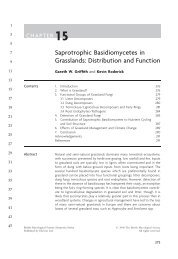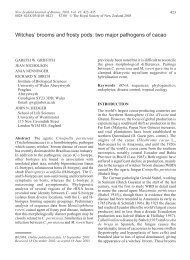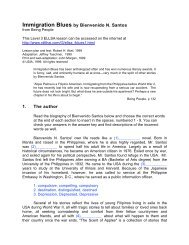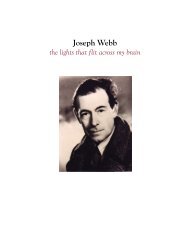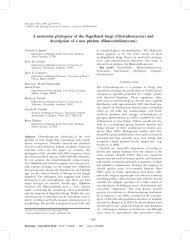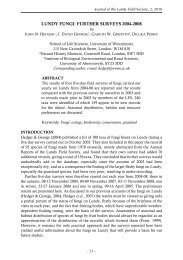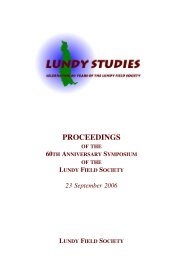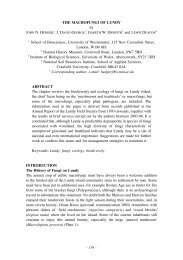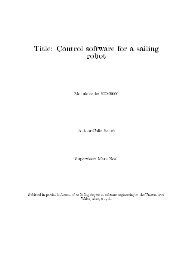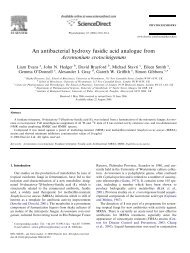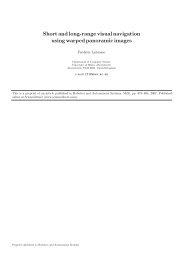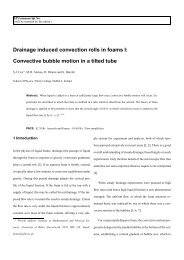Anaerobic rumen fungi
Anaerobic rumen fungi
Anaerobic rumen fungi
You also want an ePaper? Increase the reach of your titles
YUMPU automatically turns print PDFs into web optimized ePapers that Google loves.
ANAEROBIC RUMEN FUNGI<br />
al. 1993) and growth (Dehority and Tirabasso, 2000) of the former. Stewart et al. (1992) and<br />
Bernalier et al. (1993) reported an extracellular, thermo-labile protein produced by ruminococci,<br />
which inhibits fungal cellulase activity. Dehority and Tirabasso (1993) also reported that mixed<br />
<strong>rumen</strong> bacteria produce a heat stable compound in vitro, which markedly inhibits growth of<br />
<strong>rumen</strong> <strong>fungi</strong>.<br />
Since chitin is the main structural component of fungal cell wall, their growth is likely to be<br />
inhibited by <strong>rumen</strong> chitinolytic microorganisms such as Clostridium sp. Co-culturing of the<br />
anaerobic <strong>fungi</strong> with chitinolytic Clostridium tertium significantly reduced solubilization of<br />
crystalline cellulose, production of short-chain fatty acids and release of endoglucanase<br />
(Hodrova et al. 1995), suggesting the role of chitinolytic bacteria in controlling fungal activities in<br />
vivo. Thus, <strong>rumen</strong> <strong>fungi</strong> do not appear to attain their optimal fibre-degrading potential in <strong>rumen</strong><br />
due to the inhibition by some bacteria. Small sized fungal zoospores are likely to be a prey for<br />
protozoa. Co-incubation of protozoa with <strong>fungi</strong> revealed that protozoa are able to ingest and<br />
digest <strong>fungi</strong> (Morgavi et al. 1994). The fungal growth and cellulolysis is negatively affected by<br />
<strong>rumen</strong> protozoa, possibly because of protozoal predation on zoospores.<br />
11. RESPONSE TO DIVERSE DIETS<br />
The forage rich diets such as hay and silage, with a long ruminal transit time, consistently<br />
result in high population density of anaerobic <strong>fungi</strong> (Fonty and Grenet, 1994). The addition of<br />
maize to sorghum silage enhanced degradation by anaerobic <strong>fungi</strong> (Akin and Windham, 1989).<br />
Also, the addition of grain concentrate to the hay diet significantly increased the count of fungal<br />
zoospores in sheep <strong>rumen</strong> (Faichney et al. 1997). In sheep consuming appreciable amounts of<br />
fibres, a large number of sporangia are found attached to stem fragments before morning feeding<br />
(Bauchop, 1979). Fungal populations were also stimulated to a much greater extent with alfalfa<br />
diet than with coastal Bermuda grass (Windham and Akin, 1984).<br />
By contrast, diet rich in soluble carbohydrates (i.e. young pasture, whey and fodder beet)<br />
result in a relatively low population density of anaerobic <strong>fungi</strong> (Grenet et al. 1989). Silage diet<br />
from sorghum or maize reduced the numbers of anaerobic <strong>fungi</strong> in the <strong>rumen</strong> (Akin et al. 1988).<br />
Similarly, rye grass at the leafy stage, was also found unfavorable for <strong>fungi</strong> (Grenet et al. 1989).<br />
<strong>Anaerobic</strong> <strong>fungi</strong> are generally adversely affected by the addition of lipid to the diet (Jenkins,<br />
1993). Feeding a supplement of sunflower, cottonseed or rapeseed oil meal to animals also<br />
depressed fungal population in the <strong>rumen</strong> (Elliott et al. 1987; Fonty and Grenet, 1994).<br />
12. CONTRIBUTION OF FUNGI TO HOST NUTRITION<br />
Various reports suggest a positive correlation between anaerobic <strong>fungi</strong> and voluntary intake<br />
of low digestible herbage diet (Akin et al. 1983; Weston et al. 1988; Gordon and Phillips, 1993). This<br />
association is an outcome of fungal attack on lignified tissues (Akin, 1987; Akin and Borneman,<br />
1990) combined with the weakening of more recalcitrant plant components (Akin et al. 1983,<br />
1989). Soft feed fragments in the <strong>rumen</strong> may be anticipated to lead to less effort by the animal in<br />
eating and ruminating. A positive correlation between populations of <strong>rumen</strong> anaerobic <strong>fungi</strong> and<br />
rumination efficiency in sheep fed a wheat straw diet has been reported by Weston et al. (1988).<br />
Therefore, anaerobic <strong>fungi</strong> apparently facilitate the physical disruption during rumination of the<br />
fibrous particles of poor-quality feed leading to a lower residence of such particles in the <strong>rumen</strong>.<br />
The intake of forage by early weaned calves was 35% higher in calves dosed with Neocallimastix<br />
sp. (Theodorou et al. 1990), and the dosing of fungus-free sheep with Neocallimastix sp. resulted in<br />
a 40% increased intake of a straw-based diet (Gordon and Phillips, 1993).<br />
383



